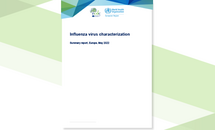Influenza virus characterisation - Summary Europe, June 2021
This is the eighth report for the 2020-2021 influenza season. As at week 24/2021, only 934 influenza detections across the World Health Organization (WHO) European Region had been reported to The European Surveillance System (TESSy); 51% were type A viruses, with A(H3N2) and A(H1N1)pdm09 being approximately equally represented and 49% were type B viruses, with only 16 having been ascribed to a lineage, 13 B/Victoria and three B/Yamagata. This represents a 99.4% drop in detections compared to the same period in 2020, probably due to the COVID-19 pandemic and measures introduced to combat it.
Executive Summary
This is the eighth report for the 2020-2021 influenza season. As at week 24/2021, only 934 influenza detections across the World Health Organization (WHO) European Region had been reported to The European Surveillance System (TESSy); 51% were type A viruses, with A(H3N2) and A(H1N1)pdm09 being approximately equally represented and 49% were type B viruses, with only 16 having been ascribed to a lineage, 13 B/Victoria and three B/Yamagata. This represents a 99.4% drop in detections compared to the same period in 2020, probably due to the COVID-19 pandemic and measures introduced to combat it.
Since the May 2021 characterisation report, one shipment from an EU/EEA country (Sweden) containing eight virus isolates was received at the London WHO Collaborating Centre, the Francis Crick Worldwide Influenza Centre (WIC); consequently, little virus characterisation data has been generated. This report therefore focuses on genetic characterisation of the HA genes of seasonal influenza viruses with collection dates after 31 December 2020, which are available in GISAID together with sequences recently determined at the WIC. The data continue to show extremely low levels of influenza detections globally.
Just 79 A(H1N1)pdm09 HA sequences from viruses detected in the 2021 season were available in GISAID, 76 of which were subgroup 6B.1A5A+187V/A, represented by A/Guangdong-Maonan/SWL1536/2019 (the vaccine virus for the northern hemisphere 2020-2021 season), and 72 of these were detected in West Africa. Sporadic detections occurred elsewhere: Belgium (n = 1), India (n=1), Norway (n = 2; both subclade 6B.1A7) and the United States (US; n = 3; one subclade 6B.1A5A+156K).
Of the 74 HA sequences from recently collected A(H3N2) viruses, one fell in subgroup 3C.2a1b+T135K-B, 13 in subgroup 3C.2a1b+T135K-A (all from Africa), and 60 in subgroup 3C.2a1b+T131K-A. The 3C.2a1b+T131K-A subgroup viruses split into two antigenically distinguishable clusters originally defined by viruses from Cambodia (n = 13; with HA1 amino acid substitutions of G186S, F193S, Y195F and S198P, and many also having K171N) and Bangladesh (n = 47; with HA1 amino acid substitutions of Y159N, T160I (loss of a glycosylation site), L164Q, G186D, D190N, F193S and Y195F), with Bangladesh-like viruses showing the greatest geographic spread. The five viruses from Sweden characterised in June were Bangladesh-like genetically and showed a HI profile of reactivity, with a panel of post-infection ferret antisera that was characteristic of that seen with a Bangladesh-like virus. An A/Cambodia/e0826360/2020-like virus (subgroup 3C.2a1b+T131K-A) has been recommended for use in the 2021-2022 northern hemisphere influenza season.
All 91 B/Victoria-lineage HA sequences were subclade 1A(3)B, with just four from the US falling in a group defined by HA1 G133R substitution; all others were from N150K group viruses with HA1 amino acid substitutions of N150K, G184E, N197D (loss of a glycosylation site) and R279K. N150K group sequences split into two subgroups, one of which, defined by HA1 substitutions V117I and V220M, was confined to 58 sequences from viruses detected in China in January while the second (n = 29 sequences), defined by HA1 substitutions A127T, P144L, E164K and K203R (with eight having additional substitutions of T182A, D197E and T221A), shows significant geographic spread. The eight viruses detected in EU/EEA countries all fell in the latter subgroup, with just one having the additional amino acid substitutions. Antigenically, viruses in subgroups of the N150K group differ and show some loss of reactivity, with post-infection ferret antisera raised against the B /Washington/02/2019 vaccine virus (recommended for inclusion in influenza vaccines for the 2020-2021 and 2021-2022 northern hemisphere seasons and 2021 southern hemisphere season). This is clearly the case for the three N150K group viruses from Sweden, characterised by HI in June.
No B/Yamagata-lineage HA sequences from clinical specimens collected in 2021, and none with collection dates after March 2020, were available. All of the 77 sequences from viruses detected in 2020, inclusive of 12 from EU/EEA countries, belong to genetic clade 3 and carry three HA1 amino acid substitutions (L172Q, D229N and M251V) compared to B/Phuket/3073/2013-like viruses, which have been recommended for use in quadrivalent influenza vaccines for the 2020-2021 and 2021-2022 northern hemisphere seasons and 2021 southern hemisphere season. The antigenic effects of these amino acid substitutions have been minimal, as assessed in earlier reports.
Download








